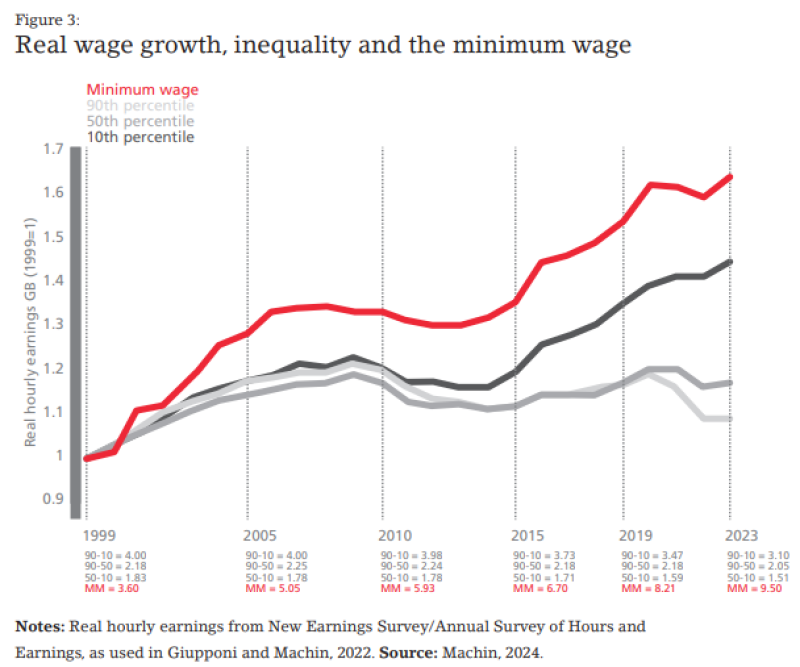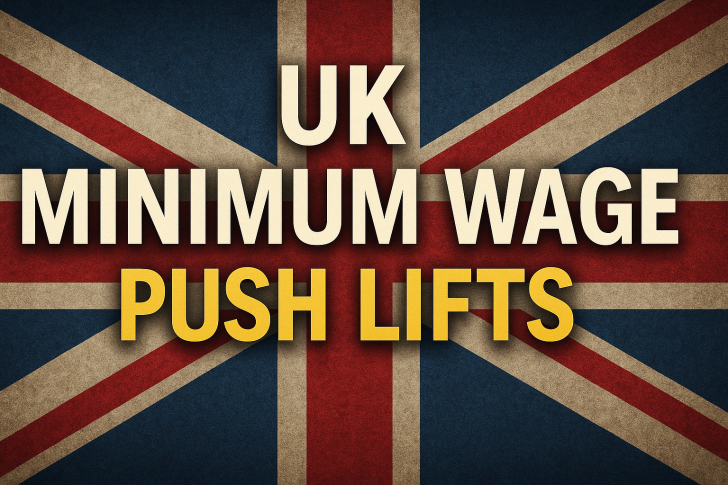Something remarkable has happened in Britain's wage structure over the past twenty-five years. The lowest earners have seen their real wages grow much faster than middle- and high-income workers — flipping the inequality trends that defined earlier decades. The main driver? A steadily rising minimum wage that has outpaced both inflation and productivity, fundamentally changing pay at the bottom of the income scale.
Wages at the Bottom Rising Fastest
While most public discussions about inequality focus on top earners, analyst Max Tempers points out that far less attention goes to the real gains made by the lowest-paid. The chart from Machin (2024), drawing on New Earnings Survey and Annual Survey of Hours and Earnings data, shows this clearly: since 1999, the minimum wage (red line) has consistently climbed faster than earnings at every other level.

By 2023, the real hourly minimum wage index hit roughly 1.65 (with 1999 as the baseline), meaning about 65% more purchasing power. The 10th percentile (light grey) and median (dark grey) posted smaller gains, while the 90th percentile (black) rose steadily but without dramatic jumps.
What the Data Reveals
The chart "Real wage growth, inequality and the minimum wage" captures three key shifts. First, the minimum wage line shoots up after 1999, levels off briefly in the mid-2000s, then climbs sharply again after 2015, reflecting government decisions to push pay floors well above inflation. Second, lower-income workers have gained the most, narrowing the gap with median earners and reducing bottom-end inequality as minimum wage hikes lifted the lowest paid. Third, after the National Living Wage launched in 2015, wage growth at the bottom accelerated noticeably, with real hourly pay for low earners rising much faster than for middle or top earners between 2015 and 2023, shown by the steeper red and light grey lines.
Policy Over Markets
This wage transformation stems from deliberate policy choices rather than market forces alone. Britain's minimum wage, introduced in 1999 and strengthened under the National Living Wage, has consistently targeted ambitious benchmarks, most recently two-thirds of median earnings. Despite worries that rapid wage increases might hurt jobs, employment among low earners has held steady. The policy has raised living standards and reduced income inequality, especially in sectors like retail, hospitality, and care work.
The Inequality Gap Narrows
While top earners (90th percentile) still outpace median growth, the gap between lowest and highest incomes has narrowed compared to the early 2000s. The chart shows wage inequality has compressed, with low earners gaining most in real terms. But keeping this going won't be easy — future minimum wage increases will need to balance business costs, inflation, and broader economic conditions.
Britain's experience demonstrates how wage policy can reduce inequality without destroying jobs. With real pay at the bottom rising faster than ever, the minimum wage has become one of the country's strongest tools for inclusive growth. The data point to a new reality: the lowest-paid workers are catching up, not falling behind.
 Usman Salis
Usman Salis

 Usman Salis
Usman Salis


